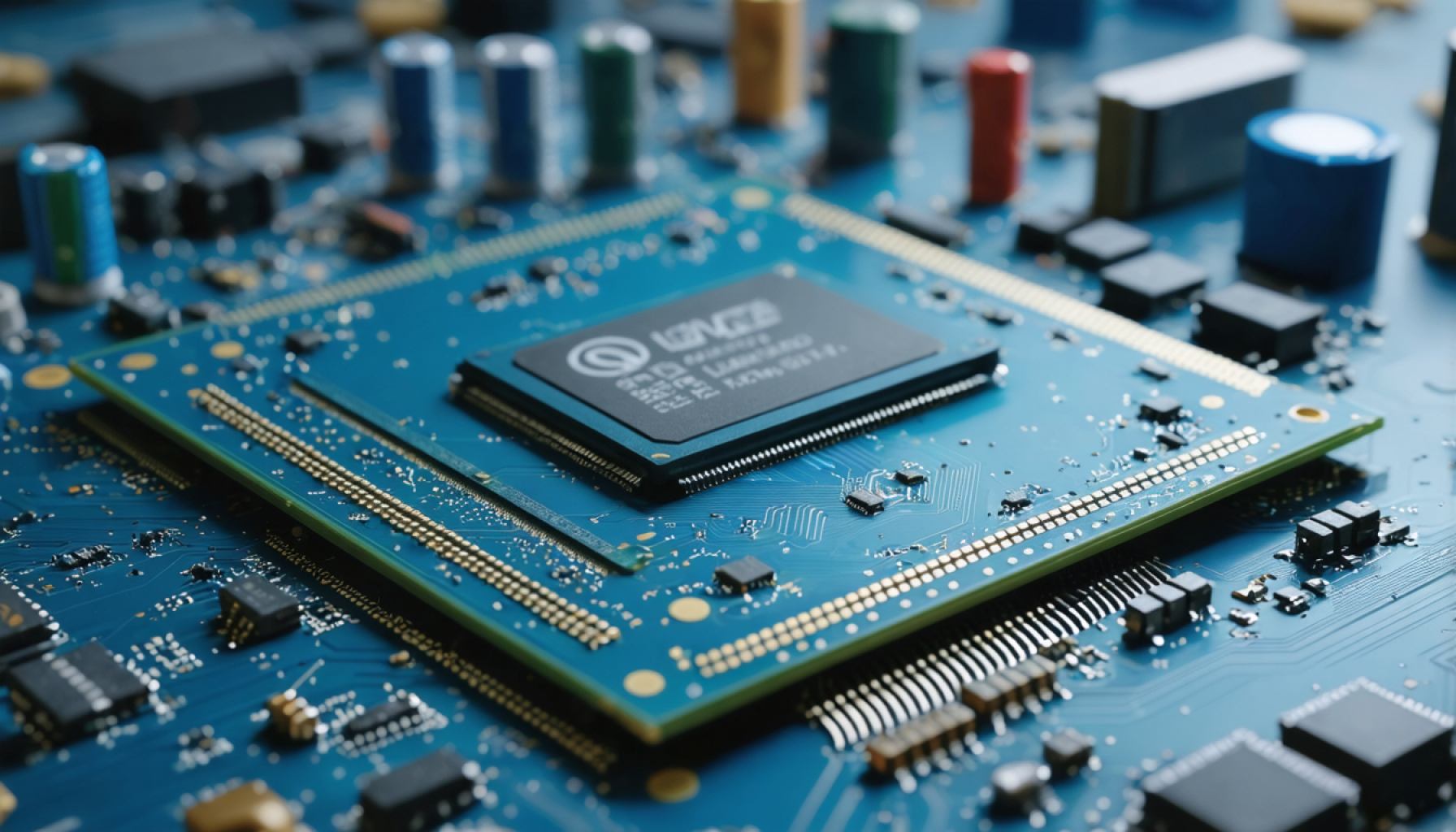- NVIDIA and Qualcomm are key players in the chipmaking industry facing potential growth opportunities.
- NVIDIA’s stock has dropped by nearly 30% but shows signs of recovery with a “double bottom” pattern and strong AI chip demand.
- Concerns linger over NVIDIA’s high valuation with a P/E ratio of 38, though analysts foresee significant upside potential.
- Qualcomm remains stable, supported by solid earnings, dividend increases, and a strong technical position.
- Qualcomm offers a lower P/E ratio of 16, appealing to value investors seeking stability and growth potential.
- Investors should decide between NVIDIA’s potential for high returns and Qualcomm’s value and stability, based on individual risk tolerance.
In the dynamic world of chipmaking, the fortunes of industry behemoths NVIDIA and Qualcomm appear to be on the cusp of change. NVIDIA Corp, celebrated for its cutting-edge graphics chips and AI advancements, recently faced a rough patch with shares sliding nearly 30% since January’s peak. Yet, there are whispers of an impending turnaround. A technical pattern known as a “double bottom” has begun to form, suggesting bullish winds might soon propel NVIDIA forward. Behind these sentiments lies NVIDIA’s recent triumph of posting unprecedented revenue, fueled by the unyielding demand for AI chips and data center hardware.
Despite this optimism, NVIDIA’s lofty valuation remains a thorny issue. The stock’s price-to-earnings ratio, towering at 38, casts a shadow for those wary of shelling out top dollar. This, however, hasn’t dimmed the enthusiasm of analysts who project a sky-high price target, envisioning a potential 100% upside. For those with an appetite for risk and growth, NVIDIA’s allure is undeniable.
Qualcomm Inc., in contrast, has been a quiet contender, progressively laying the groundwork for a bullish surge of its own. It may not command the media spotlight like NVIDIA, but Qualcomm has shown steadfast resilience, anchoring itself on a robust long-term support line. This stability, coupled with a winning earnings report and a promising dividend boost, reflects a company confidently eyeing future growth.
From a valuation standpoint, Qualcomm stands out as a tantalizing choice. With a price-to-earnings ratio of merely 16, it offers a tempting proposition for value hunters and the cautious investor. While its lack of recent analyst upgrades might raise eyebrows, the absence of coverage belies a compelling underlying strength, marked by solid fundamentals and a passable technical position set up for Q2.
The takeaway: both NVIDIA and Qualcomm offer promising paths ahead into the second quarter. Enthusiastic growth investors might gravitate towards NVIDIA, banking on its momentum and analyst support, despite its premium price. Conversely, those seeking value and less volatility may find Qualcomm’s steadiness and attractive valuation irresistible.
In this clash of titans, each investor must weigh their appetite for risk against the potential for reward. As the chipmaking giants prepare for a substantive Q2, the choice—anchored by strategy and risk tolerance—is yours to make.
NVIDIA vs. Qualcomm: The Chipmaking Titans’ Future Potential
Market Overview and Future Predictions
In the ever-evolving landscape of the semiconductor industry, NVIDIA and Qualcomm continue to dominate discussions among investors and tech enthusiasts alike. Both companies are positioned to potentially reshape the market in their own ways, as technological advancements drive demand for their respective products. Here’s a deeper dive into their prospects, addressing key considerations and questions pertinent to investors:
NVIDIA’s Strategic Position
AI and Data Center Dominance
NVIDIA has carved a niche in the AI and data center sectors, primarily due to its GPUs’ capability to accelerate machine learning tasks. The demand for AI hardware has substantially increased, reinforcing NVIDIA’s potential for growth.
Technical Analysis
– Double Bottom Pattern: This technical pattern suggests a potential reversal in NVIDIA’s recent stock price decline, hinting at a bullish future.
– Price-to-Earnings Ratio (P/E): At 38, its valuation may appear steep, but investors are optimistic about an upward trajectory, expecting significant returns.
Industry Trends
AI and machine learning applications are expanding across industries such as healthcare, finance, and autonomous driving. NVIDIA’s GPUs are critical in these sectors, especially as projects like self-driving cars advance.
Qualcomm’s Subtle Strength
Market Position
Unlike NVIDIA, Qualcomm thrives quietly, underpinned by a solid support line. The company’s consistent performance and future growth are tied to its leadership in mobile technology and investment in next-generation 5G infrastructure.
Valuation and Financial Health
– P/E Ratio: Qualcomm’s valuation is attractive at 16, offering value-seeking investors a bargain.
– Dividends: Recent increases in dividends signal the company’s confidence in steady, long-term growth.
Real-World Applications
Qualcomm’s chips are integral to the smartphone market, and its foothold in the 5G segment positions it favorably as the world becomes increasingly connected.
Pressing Questions Answered
1. What are the strategic differences between NVIDIA and Qualcomm?
– NVIDIA focuses heavily on AI and data centers, while Qualcomm emphasizes mobile communications and 5G technology.
2. Which company presents a better investment opportunity?
– Growth-oriented investors may prefer NVIDIA for its cutting-edge innovations and market momentum, despite a higher valuation. Conversely, Qualcomm appeals to those prioritizing steadiness and value.
3. How do current market trends impact both companies?
– The burgeoning AI market significantly boosts NVIDIA, while Qualcomm benefits from the expansion of 5G and mobile technology.
Actionable Recommendations for Investors
– Assess Risk Tolerance: Determine your preference for high-risk, high-reward investments versus stable, value-driven opportunities.
– Monitor Industry Trends: Stay updated on AI and 5G developments, as these will greatly influence the companies’ futures.
– Diversify Your Portfolio: Consider a balanced approach by investing in both companies to mitigate risk and capitalize on their respective strengths.
Related Links
For further information on these companies, visit:
– [NVIDIA](https://www.nvidia.com)
– [Qualcomm](https://www.qualcomm.com)
In conclusion, as both NVIDIA and Qualcomm gear up for a promising Q2, investors should weigh their strategies carefully, taking into account industry dynamics, technical indicators, and financial health. Whether your interest lies in the high-tech allure of AI or the stable demand for mobile infrastructure, these chipmaking giants offer distinct pathways to potential financial success.
